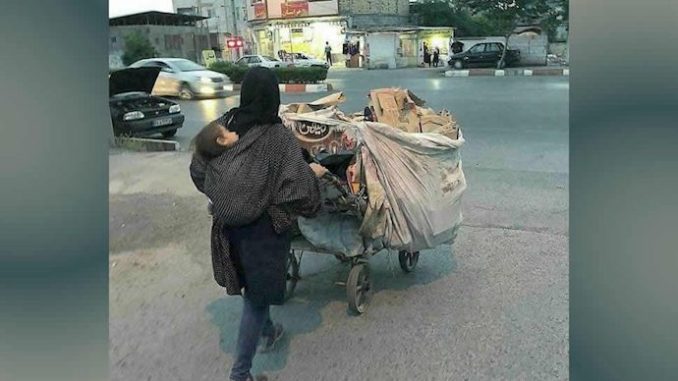
The population of poor women in Iran, especially the female head of households, is increasing year by year and women’s vulnerability to poverty is much higher than men and rising.
The expression “feminization of poverty” has become a common term among the government officials and experts, because due to the corrupt and unpopular governance of the Velayat-e Faqih regime and their plundering and anti-people policies, both general poverty and the poverty of women-headed households in Iran are on the rise.
Poverty of Female Head of Households
According to Ali Rabiei, the Minister of Labor of Hassan Rouhani’s government, there are currently 3,200,000 women head of households in Iran, of whom only 200,000 are under the coverage of the welfare organization, (State-run Tasnim news agency, May 31, 2018).
Of course, the figures do not include all female headed households, because as former member of the regime’s reactionary parliament, Mojtaba Rahmandoust, said, considering the current situation of survey, it is difficult to identify all the poor, especially poor women and female headed households because there is no “specific mechanism” in the clerical regime for surveying (State-run TV, August 16, 2015).
In this regard, Alimohammad Zolfaghari, health and support deputy of the regime’s Relief Committee has said earlier that the number of poor women in the household who refer to the Relief Committee to receive support is increasing every day such that the number has increased from 2 million and 500 thousand in 2015 to 3 million and 500 thousand people currently.
However, according to Tayebeh Siavoshi, a member of the regime’s parliament, the statistics of female heads of household varies and is estimated to be up to 5 million, (Parliament news agency, August 7, 2017).
Women Head of Households, Forgotten by the Regime’s Social Welfare Organization
In the field of welfare assistance to these households, the deputy of social welfare organization asserted that the government did not have enough resources to help the organization, and its assistance to the sponsored families was on average for each family, even for five-person households, “between 65 to 70 thousand Toman (about $20 US dollar) per month,” (Iran regime’s TV, August 16, 2015).
Some of these women and their families are covered by the Relief Committee, whose monthly pension is about 100 thousand Toman.
The fact is that the amount paid to these women and their families does not solve any problems for them; this is paid by the welfare organization and the Relief Committee solely for the purpose of eliminating the problems on the surface and evading their responsibilities to these families, and clearly while the poverty line is about 5 million Toman, paying 70 thousand or 100 thousand Toman is not sufficient even for buying bread only. These households are among the 30 percent hungry people who, according to the regime’s Deputy Minister of Health, cannot afford to buy even bread to feed themselves.
Discrimination and Inequality, Unemployment and Lack of Social Security
The problem of the Iranian women head of households and their families is not just poverty, but discrimination and inequality, unemployment, and social insecurity are three of their main problems.
Most of these fellow citizens are living in slums or on the sidelines of the city, without housing and without jobs, and they are not able to afford the minimum living expenses, including bread money, for the elimination of hunger.
The future vision for them and their families is no more than poverty and loneliness, because the cost of livelihood is steadily rising, while 80% of these women are unemployed and have no sources of income to provide for the livelihood their dependent families and there is no employment opportunity for them. Their only source of income is a meagre and insignificant amount of a few thousand Toman donation by social welfare and relief committee that goes nowhere.
What has been said about the problems of women head of households is a small part of their problems, which cannot really reflect the catastrophe that these fellow citizens and their families are currently facing.
These compatriots are victims of poverty, discrimination and inequality that are institutionalized and expanding in the regime of Velayat-e faqih. These women carry on their shoulders a mountain of problems and suffering in the evil rule of the mullahs that can only be relieved by the overthrow of the regime in Iran and establishment of a new democratic government that guarantees freedom, equality and social justice.

